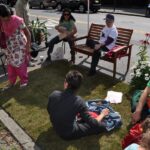
The idea of a “pop-up” is not new, but has been rapidly trending the past decade. As a young adult living in a metropolitan area, pop-up stores, bars, and events, seem to be a common occurrence. I have even visited a few myself. In the planning field we have seen this flexible concept, transform into a strategic type of planning.
Pop-up urbanism, also known as DIY or tactical urbanism, takes a low-cost and dynamic approach in repurposing public space. This approach is small scaled, low-risk, and short-termed. It can achieve community engagement and the enhancement of public space. While these projects create temporary actions or improvements, they can often make lasting changes to neighborhoods.
Pop-up urbanism could be described as a live lab, where different usage or solutions are tested and community interests are gauged. The projects range and vary for each community, but there are a few programs that are used worldwide.
PARK(ing) Day
Park(ing) Day was formed in 2005 by an art and design studio, Rebar. The idea is to take back a metered parking spot and use the “site for creative experimentation, political and cultural expression, and unscripted social interaction.” These spaces have held a large variety of events, ranging from a free bicycle repair shop to a public kiddie pool. This concept gives local businesses, non-profits, city departments, and citizens an opportunity to express their ideas and hopefully spark public interest in how their environment is transformed. International Park(ing) Day takes place the third Friday of September, which is just around the corner! Cities and counties around the National Capital Region, like the City of Alexandria, Arlington County, and the District of Columbia will be participating in Park(ing) Day this year.
Pavement to Plazas
Pavement being converted to plazas was made well known after New York City closed Time Square to vehicles, turning it into a pedestrian plaza. Many other communities have adopted similar pilot programs like the NYC Plaza Program. The NYC Plaza Program guidelines have three main types of plazas to choose from: one-day plaza, interim materials plaza, and permanent materials plaza. A one-day plaza gives an opportunity to test a proposed plaza site and gain local support. This is a low-cost opportunity that with inexpensive materials can create new public space. With the right amount of support and planning these temporary plazas can become permanent sites.
Bigger Picture
Pop-up urbanism has a long list of programs. There’s chair bombing, better block initiatives, food trucks and vendors, guerilla gardening, open streets, and pop-up parks. While these programs have seen success, it is crucial that a community not relay on just one tool or strategy—like pop-up urbanism— when enhancing public space. LSA’s Cambridge Neighborhood Revitalization Plan was approved by City Council this summer where pop-up urbanism pilot projects was one out of five strategies for enhancing and activating public spaces. If you would like to learn about the other four, check out the plan!




